Carbohydrates Chemistry
Carbohydrates are organic compounds composed of carbon (C), hydrogen (H), and oxygen (O) in the general formula (CH₂O)n. They are classified based on their structure and complexity.
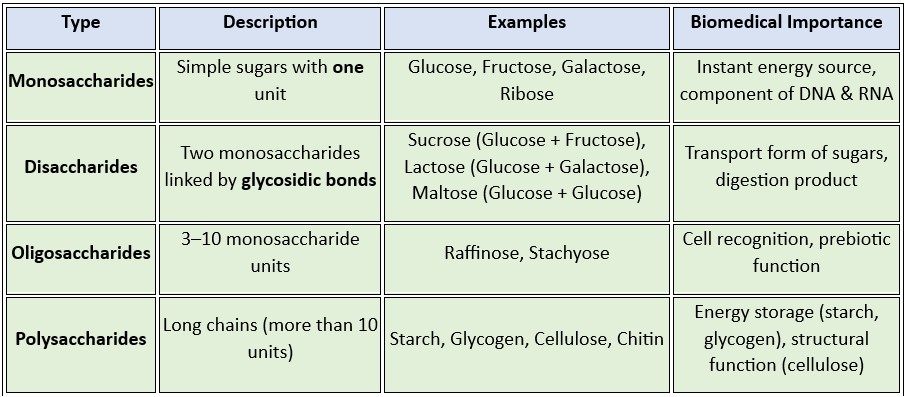

1. Classification Based on Structure
2. Classification Based on Function


Polysaccharides are complex carbohydrates composed of long chains of monosaccharide units linked by glycosidic bonds. They serve structural, storage, and functional roles in biological systems.
Polysaccharides are essential biomolecules that play crucial roles in energy metabolism, structural integrity, joint lubrication, cardiovascular health, and immune function. Their biomedical applications extend to medicine, nutrition, and tissue engineering.
Classification of Mucopolysaccharides (GAGs) and Their Importance
Invert Sugar & Chondroitin Sulfate
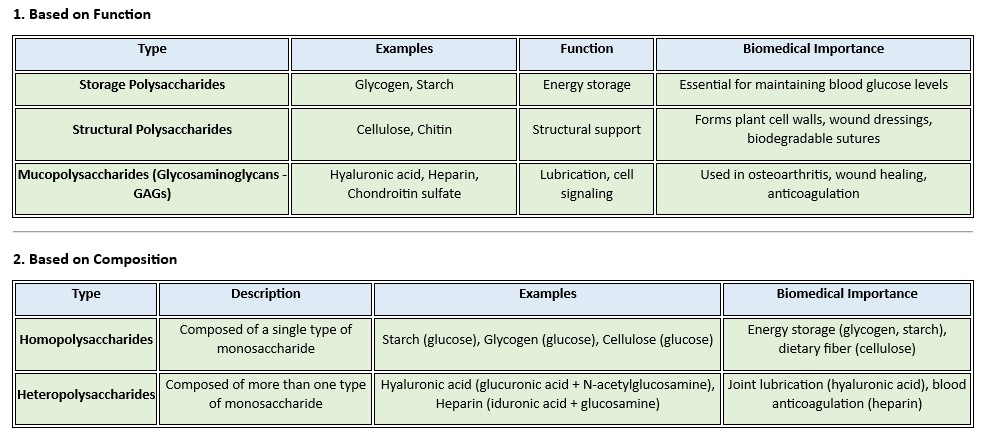

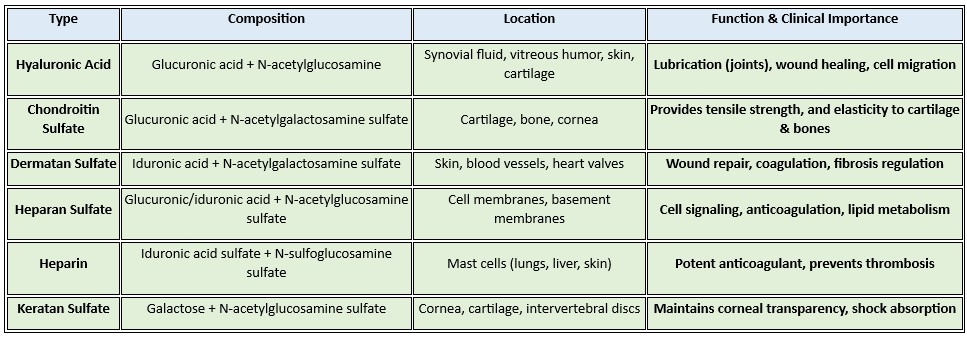

Mucopolysaccharides (GAGs) are biologically essential polysaccharides that play vital roles in tissue structure, lubrication, blood coagulation, cell signaling, and disease pathology. Their clinical significance extends to therapies for joint disorders, wound healing, cardiovascular diseases, and genetic metabolic disorders.
Biomedical Importance of Mucopolysaccharides (GAGs)
1. Structural Function in Connective Tissues
GAGs are key components of the extracellular matrix (ECM), providing strength, elasticity, and hydration to tissues.
Chondroitin sulfate and keratan sulfate contribute to the resilience of cartilage, tendons, and ligaments.
2. Joint Lubrication and Shock Absorption
Hyaluronic acid is present in synovial fluid, where it reduces friction and absorbs mechanical shocks in joints.
It also maintains hydration in the skin and eyes, preventing dryness and wrinkles.
3. Role in Coagulation and Anticoagulation
Heparin is a natural anticoagulant that inhibits clot formation by enhancing antithrombin III activity, preventing conditions like deep vein thrombosis (DVT) and pulmonary embolism.
4. Cell Signaling and Growth Regulation
Heparan sulfate is involved in cellular signaling, regulating growth factors (FGF, VEGF) for angiogenesis, immune response, and wound healing.
5. Role in Corneal Transparency and Vision
Keratan sulfate is crucial for corneal transparency, preventing light scattering and supporting vision.
Hyaluronic acid in the vitreous humor of the eye maintains shape and protects the retina
6. Wound Healing and Tissue Repair
Dermatan sulfate and hyaluronic acid stimulate fibroblast activity, accelerating wound healing and scar formation.
7. Role in Drug Delivery and Cancer Therapy
GAGs are used in drug delivery as carriers for targeted chemotherapy and controlled drug release systems.
Hyaluronic acid-based formulations enhance drug penetration in tumor microenvironments.
8. Inborn Errors of Metabolism – Mucopolysaccharidoses (MPS)
Mucopolysaccharidoses (MPS) are lysosomal storage disorders due to enzyme deficiencies, leading to the accumulation of GAGs in organs and causing skeletal, neurological, and cardiac abnormalities.
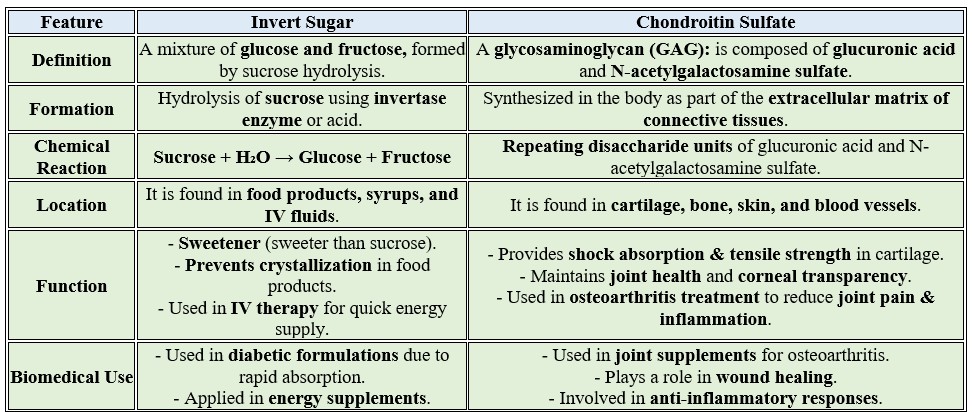

Introduction
Mucopolysaccharides, now referred to as Glycosaminoglycans (GAGs), are long, unbranched polysaccharides composed of repeating disaccharide units. These consist of an amino sugar (glucosamine or galactosamine) and a uronic acid (glucuronic acid or iduronic acid). They are widely distributed in connective tissues, synovial fluid, extracellular matrix (ECM), and cell surfaces, playing essential roles in structural support, lubrication, and cellular signaling.
Biomedical Importance of Polysaccharides
1. Energy Storage & Glucose Homeostasis
Glycogen (animal storage polysaccharide) helps regulate blood glucose levels in the liver and provides muscle energy.
Starch (plant storage polysaccharide) is a major dietary carbohydrate that provides sustained energy.
2. Structural & Protective Functions
Cellulose is an indigestible fiber in the human diet, promoting gut motility and preventing constipation.
Chitin forms the exoskeleton of insects and is used in biodegradable surgical sutures.
3. Joint Health & Lubrication
Hyaluronic acid is used in joint injections for osteoarthritis and eye drops for dry eyes.
4. Blood Clot Prevention & Cardiovascular Health
Heparin, a natural anticoagulant, prevents blood clot formation, reducing the risk of deep vein thrombosis (DVT) and stroke.
5. Role in Wound Healing & Tissue Repair
Chondroitin sulfate and dermatan sulfate promote wound healing and skin regeneration.
Hyaluronic acid accelerates wound healing by promoting fibroblast migration.
6. Immune Modulation & Anti-Inflammatory Effects
Dextran, a bacterial polysaccharide, is used in plasma volume expanders to treat shock and blood loss.
Fucoidan, a marine polysaccharide, has anti-inflammatory and anticancer properties.


Therapeutic and Clinical Applications of GAGs


Biomedical Functions of Carbohydrates
(Carbohydrates play a crucial role in the body.)
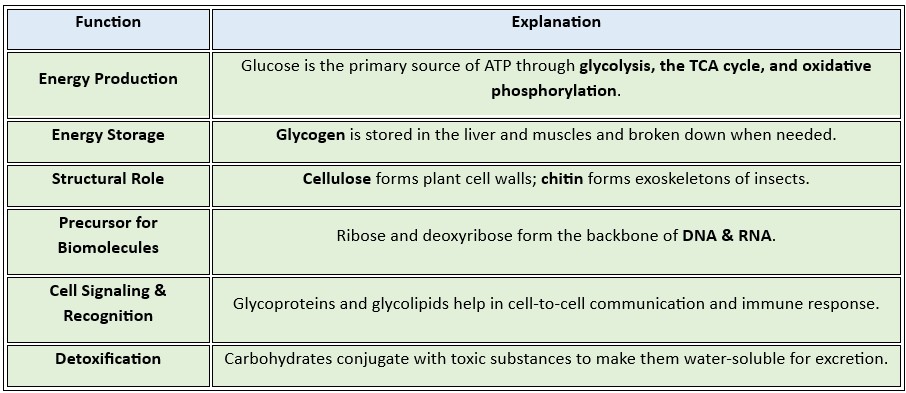

Reactions of Carbohydrates (Tabulated Format)
Carbohydrates undergo several biochemical reactions essential for metabolism and physiological functions.
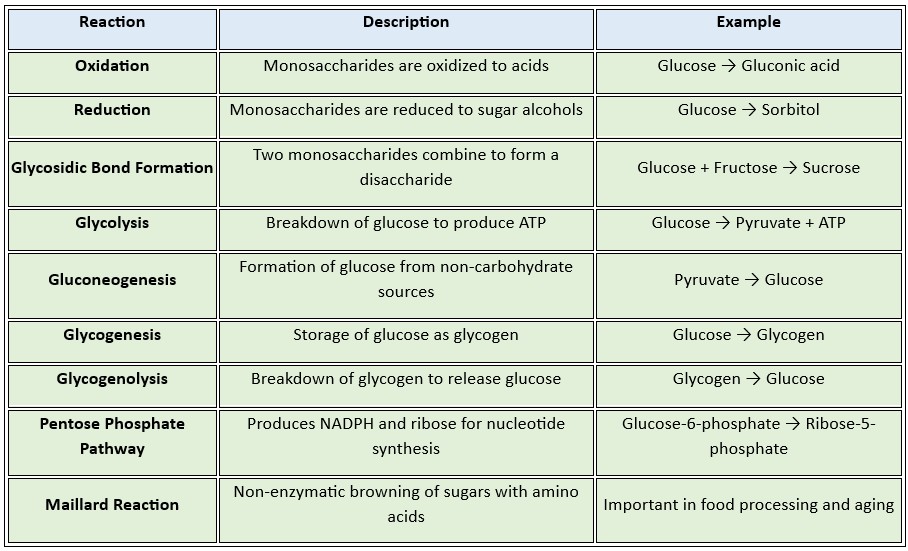

A detailed and structured explanation of the qualitative identification of carbohydrates using laboratory tests is needed. The information is presented in a tabulated format for easy understanding.
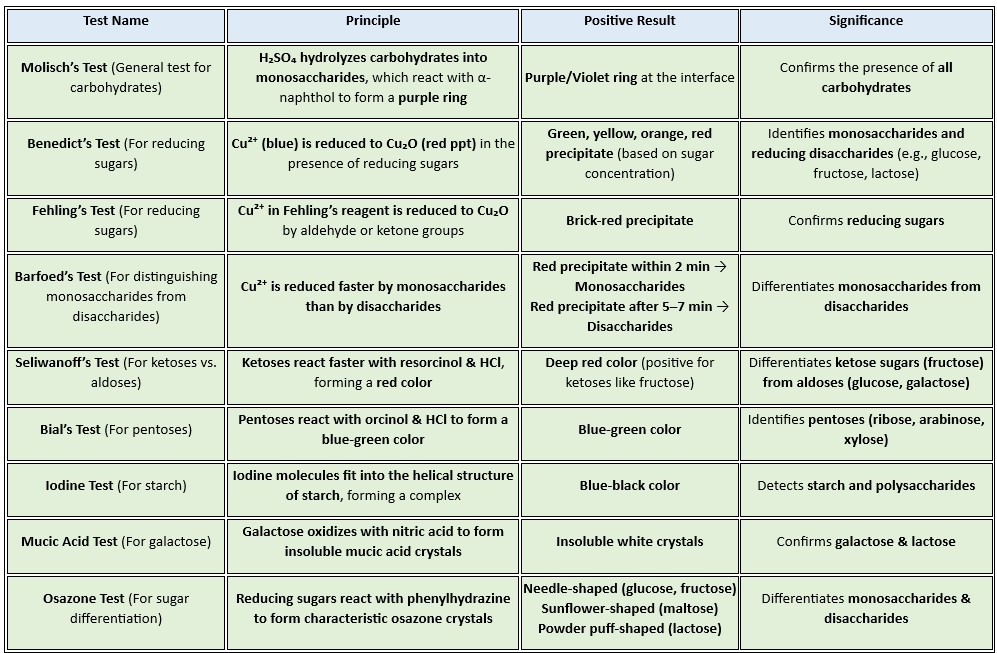

Reactions Involved in Carbohydrate Identification
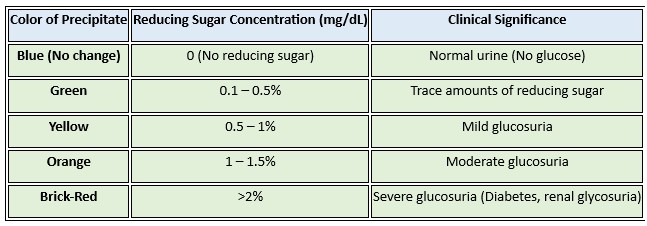



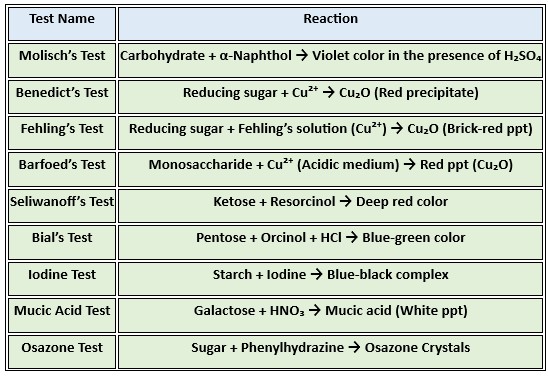

Clinical Importance of Benedict’s Test
Benedict’s test is a qualitative test used to detect the presence of reducing sugars (such as glucose, fructose, lactose, and maltose) in biological samples, primarily urine and blood. It is widely used in the diagnosis and monitoring of metabolic disorders.
1. Clinical Applications of Benedict’s Test
2. Interpretation of Benedict’s Test in Urine Analysis
Benedict’s reagent reacts with reducing sugars to form colored precipitates, indicating their concentration in the sample. The color change corresponds to the amount of sugar present.
3. Limitations of Benedict’s Test
Non-specific for glucose → It detects all reducing sugars, so further tests like the glucose oxidase test are needed for confirmation.
False Positives → Can occur due to the presence of ascorbic acid (vitamin C), drugs, or certain antibiotics.
False Negatives → Highly dilute urine or certain conditions may give misleading results.
Benedict’s test is a valuable screening tool for detecting sugar abnormalities in urine, helping in the early diagnosis of diabetes, renal disorders, and inherited metabolic diseases. However, confirmatory tests are required for precise diagnosis.
Types of Polysaccharides
BLOG
Join us to explore medical biochemistry intricacies.
WRITE TO US
© 2024. All rights reserved.
